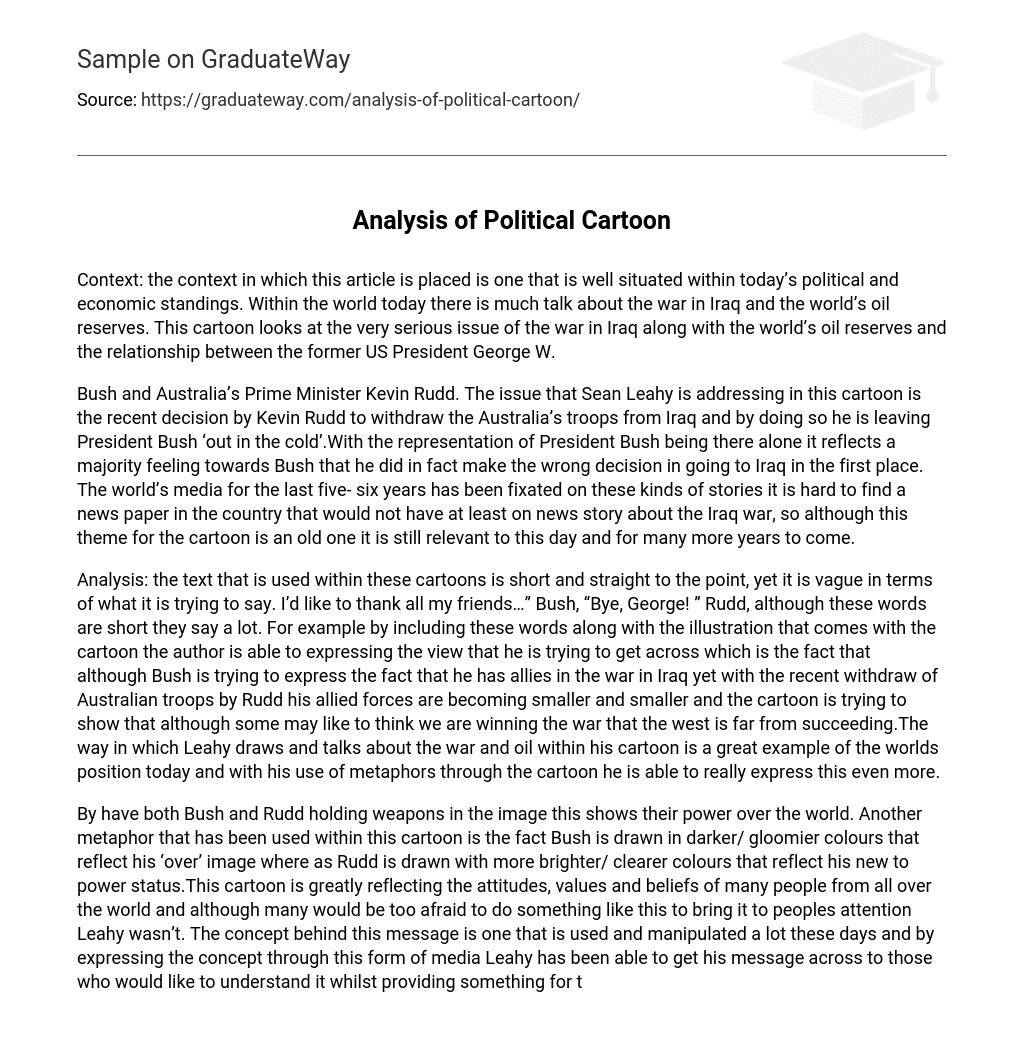The article presents an analysis of the Iraq war and its correlation with global oil reserves, in light of today’s political and economic climate. It explores the connection between ex-president George W. Bush and the oil reserves, emphasizing the gravity of this matter.
The cartoon criticizes Australia’s Prime Minister Kevin Rudd for his recent decision to withdraw troops from Iraq, which has resulted in President Bush being left alone. It reflects the commonly held belief that Bush made an incorrect decision by initiating the Iraq war. This theme remains significant and everlasting because of the media’s ongoing coverage of similar stories over the past five to six years.
Analysis: The text used in these cartoons is concise and direct, but it lacks clarity in its message. The words “I’d like to thank all my friends…” Bush, “Bye, George!” Rudd may be brief, but they carry significant meaning. By pairing these words with the accompanying illustration, the author effectively conveys the message that Bush’s claims of having allies in the Iraq war are diminishing due to Rudd’s withdrawal of Australian troops. The cartoon aims to illustrate that despite optimistic beliefs in winning the war, the Western forces are far from successful. Leahy’s depiction and discussion of the war and oil in his cartoon serve as a reflection of the current global situation. Through his use of metaphors, the cartoon emphasizes this point even further.
By depicting both Bush and Rudd with weapons in the image, it symbolizes their authority over the world. Another metaphor employed in this cartoon is the use of darker and gloomier colors to represent Bush’s overwhelming image, while brighter and clearer colors are used for Rudd to convey his relatively new status in power. This cartoon effectively represents the perspectives, principles, and beliefs of people worldwide. Despite potential fear, Leahy bravely brings attention to this issue. The underlying message in this artwork is a frequently used and manipulated concept nowadays. By expressing it through this form of media, Leahy effectively communicates his message to those interested in understanding it, as well as provoking thought among those who may not have previously grasped its significance.
Cartoon Two: Demonstrating effective leadership in resolving the petrol crisis… [pic] Leahy, S. (2010) Showing Real Leadership on Solving The Petrol Crisis…. Retrieved 28th May 2010, http://www. news.
The rising cost of living, particularly fuel prices, is a major issue in today’s global society. A cartoon featured on com.au/couriermail/ highlights the belief that the war in Iraq is a key factor contributing to the increasing fuel prices. The frame of the cartoon expresses the nation’s anger not only towards the rising fuel cost but also towards the government’s perceived inaction on this matter.
This article reflects the public’s anger towards the government’s refusal to address the issue and their hypocrisy in claiming to care about it. The cartoon primarily focuses on the current fuel prices in Australia, which are contributing to the financial difficulties faced by families. The public wants the government to take action and resolve this problem, but their pleas are being ignored. The cartoonist, Leahy, expresses the public’s frustration towards the government through the statement “AT LAST! Showing Real Leadership on Solving the Petrol Crisis…” The bold letters used for “AT LAST!” emphasize the collective frustration felt by Leahy and the public towards the government’s handling of the price increase.
The imagery in the cartoon is significant in conveying the idea that the government is not effectively addressing the issue of rising fuel prices. By depicting Rudd waiting for a bus, it suggests that the government’s actions merely encourage the use of alternative transportation rather than truly resolving the problem. Leahy portrays the public’s frustration and resentment toward the government by appealing to their attitudes, values, and beliefs. Through metaphors and discussion in local and national media, Leahy is able to capture readers’ attention and shed light on crucial issues that require government intervention. Using Rudd’s image as the person waiting at the bus stop adds a personal touch to emphasize these concerns, rather than using just any member of the general public.





